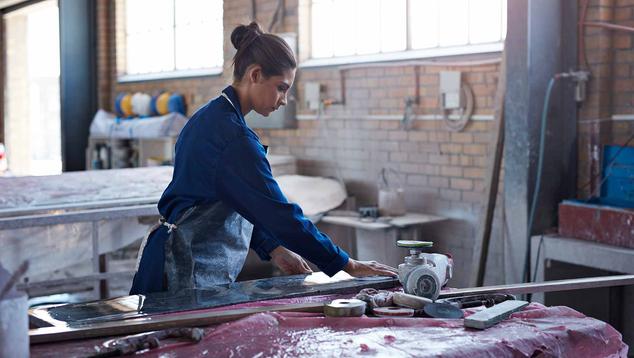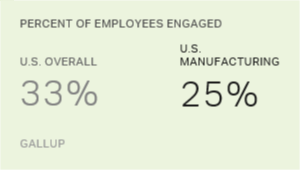Story Highlights
- Manufacturers need to recruit more women to fill the labor shortage
- Understanding what women want can help you create a better value proposition
- Addressing the male-dominated aspects of manufacturing can improve inclusion
Manufacturing has a critical shortage of skilled workers -- more than 2 million are needed now, and the problem is getting worse. But very few women are rushing to fill the gap.
Just 29% of manufacturing's labor force is female, including only 7% in middle-skilled jobs.
That's not because women don't want to work in manufacturing -- among those who do, more than 70% say they'd stay in manufacturing if they were to start their career today, according to a Manufacturing Institute study, and 42% would encourage their daughter or a female family member to work in the industry.
The industry has responded to the labor shortage with initiatives to recruit more women -- including job boards, industry events and training programs -- making the case that women can find a career in manufacturing to be incredibly fulfilling and rewarding. Which is verifiably true. But those 2 million jobs remain unfilled.
Recruiting women in manufacturing might be more successful if leaders approached the problem in reverse: Instead of telling women what manufacturing offers them, learn what women want from manufacturing jobs.
Gallup research shows that effective recruitment in any industry begins with drafting an employee value proposition that offers what matters most to the workers you want. According to Gallup's Women in America: Work and Life Well-Lived report, the two most important workplace factors for women are the ability to do what they do best and work-life balance.
Gallup expertise can help leaders put those principles to practice before their labor shortage turns into a business crisis.
Recruiting women in manufacturing might be more successful if leaders approached the problem in reverse: Instead of telling women what manufacturing offers them, learn what women want from manufacturing jobs.
What I Do Best
To a worker, "what I do best" is a reflection of two things: skills and talent. Only a third of workers can strongly agree that they have the opportunity to do what they do best every day.
Companies that don't make the most of employees' skills and talent squander their workers' performance potential.
Here's how to rectify that mistake: Assess, deploy and develop what workers do best. Every day.
Assessing talent is simple -- Gallup does it every day for thousands of work units in companies around the world. Many of those companies incorporate the CliftonStrengths assessment (a scientifically validated approach to identifying individuals' patterns of thought, feeling or behavior) because, among other things, CliftonStrengths offers insight into individuals' areas of greatest talent: the inborn, unlearnable abilities that explain the difference between "capable of" and "excellent at."
Those differences can be subtle, but they have a massive impact on the bottom line. Strengths-based companies have higher productivity, fewer sick days, fewer on-the-job accidents, and much higher profitability and retention. One manufacturing company Gallup worked with faced an 85% turnover rate, which dropped to 8% within two years of implementing the CliftonStrengths program. Its productivity shot up 200% and profitability increased 233% along the way.
Talent is innate. It can't be taught. But skills can, and they accrue over time. Seasoned workers who know where their skills lie should be put to that work. Managers should go out of their way to make it happen.
But employees new to the industry haven't had time to discern or develop their skills. Women are so scarce in manufacturing that to recruit them is, very often, to recruit novices. On-the-job training or tuition reimbursement -- if you offer it -- can be a vital part of your employee value proposition.
Education, whether it comes in a classroom or on the floor, is highly valuable in manufacturing. And women should feel encouraged to get it, not sidelined for lacking it.
Women are perhaps more likely than men to think they have to be 100% qualified to be hired -- which reflects their lack of confidence in hiring managers, not themselves. So emphasizing that you train your own is important.
Education, whether it comes in a classroom or on the floor, is highly valuable in manufacturing. And women should feel encouraged to get it, not sidelined for lacking it.
Job Flexibility
Second on the list of qualities that women want in a job is work-life balance. Most workers are "categorically" willing to leave their jobs for greater job flexibility, according to Gallup's State of the American Workplace report.
Gallup and the International Labour Organization partnered on another report, Towards a Better Future for Women and Work: Voices of Women and Men, which found that both men and women say that of the biggest challenges working women face, three of the top four relate to inflexibility in the workplace.
As far as flexibility goes, small manufacturing companies may have an advantage over big companies.
As the Women in America report notes, "Many small companies are focusing on benefits and perks that are a bit more manageable financially but also represent their culture and accommodate their employees' lifestyles. They are offering employees the flexibility, autonomy and development they want and establishing work environments that feel less like traditional, inflexible corporate cultures."
Flexibility that fits the customer, the culture and the budget requires some creativity -- changing shift hours to coincide with school hours, say, or a corporate partnership with a healthcare center, or real commitment to paternity leave -- but a smaller org chart can make it easier to resource workers to the work on a schedule designed to match the needs of both customers and employees.
Regardless of size, however, companies need to be thoughtful about communicating new policies. Workers who have given years of loyal service may feel the sudden adoption of flexibility is not a benefit to them but a bribe to women. That breeds resentment of women and disgust with leaders.
So communicate that flexibility is for all employees' wellbeing -- and that everyone fosters their wellbeing differently. A shift sharing program allows parents to get kids to the dentist just as much as it allows fishermen to get to the lake and softball players to get to their games.
However, no matter how well-crafted and carefully messaged its flexibility policies, nor how well it matches talent to job role, a manufacturing company will fail to retain the women it recruits if its workplace culture is not inclusive.
Inclusiveness
To put it bluntly, manufacturing has a reputation for sexism and harassment. Nothing leaders do to recruit women will matter if the women they hire are disrespected on the job.
Leaders know the importance of a sexual harassment policy that includes a mechanism for reporting harassment complaints confidentially and a procedure for disciplining offenders.
That's good.
It's not enough.
Sexual harassment policies deal with egregious offenses. They don't create culture. Leaders and managers do. Leaders establish "what we believe in around here." Managers implement it.
To retain women, "what we believe in around here" has to involve inclusion, and managers must make it so.
Gallup's Three Requirements of a Diverse and Inclusive Culture - and Why They Matter for Your Organization report defines inclusiveness as "the extent to which diverse employees are valued, respected, accepted and encouraged to fully participate in the organization."
Three requirements of a diverse and inclusive culture, Gallup finds, are:
-
Employees are treated with respect. Ninety percent of those who say they are not treated with respect report at least one of 35 different discrimination or harassment experiences at work.
-
Employees are valued for their strengths. Employees must be recognized for the unique perspectives they bring and the things they do exceptionally well.
-
Leaders do what is right. Culture cascades down. Workers are likelier to behave ethically if they believe leaders do.
With that in mind, consider this Gallup finding: The 50th percentile for employee engagement in the manufacturing industry database always trends below the 50th percentile in our overall industry database. So if manufacturing workers are just plain less engaged, on average, than other employees, there must be some inherent obstacle to creating and sustaining engagement. And because engagement links to productivity, safety, talent retention and profitability, that problem costs manufacturing organizations in financial and human terms.
Meanwhile, other Gallup research shows that female managers tend to create more highly engaged teams than male managers do. But it's improbable that women will ascend to management in an industry that ignores their needs. And leadership that makes them feel unwelcome -- by shrugging off disrespectful behavior, or by devaluing the contributions or perspectives of women -- will undo any efforts the industry makes to recruit more women.
Which is not to suggest that women are so fragile and demanding that manufacturing leaders must treat them deferentially and gently. That's condescending, and it's not true.
But it's also condescending and untrue to imply that any of this is easy.
Culture Change
Determining what workers do best and managing them toward it, creating solution-oriented flexible policies, and developing a genuinely inclusive workplace -- that's hard work. It's what all workers want, it's proven to improve performance, and it boosts profitability … but it's still hard work.
It's culture change. And changing cultures is tough. To implement those changes in an established workforce impacts everyone from the shop floor to the C-Suite. Leaders have to commit, managers have to learn, and workers have to engage with a change initiative or the whole thing falls apart.
But it can be done, and done effectively.
Gallup has helped thousands of companies with millions of employees make "the way we do things around here" more productive, profitable and engaging. Just plain better.
And in manufacturing, it needs to get better -- fast. Two million unfilled jobs means an untold number of unfilled orders.
Customers don't care that myopic but entrenched approaches to staffing and management have created gender-related difficulties in labor recruitment and retention.
Customers just want their orders filled.
So yes, changing your company culture to recruit and retain women in a historically male-dominated industry is hard. But manufacturers may not have much choice.
Staying in business requires labor, and the labor pool is small and getting smaller. Manufacturing's employee value proposition isn't gaining traction. Customers are frustrated. The situation may get far worse before it gets better.
Leaders can look at that as a doomsday report, or they can see past the problem to spot the opportunity. There are 74.6 million women in the U.S. workforce, representing a big opportunity. A big missed opportunity.
Capitalizing on the potential will almost certainly mean changing the way business is done in small ways and big ones. That takes hard work and real commitment to the job. But hard work and commitment are part of manufacturing's self-image.
Expand that self-image to include female faces -- about 2 million of them -- and manufacturing's future could look better and more profitable than its present.


